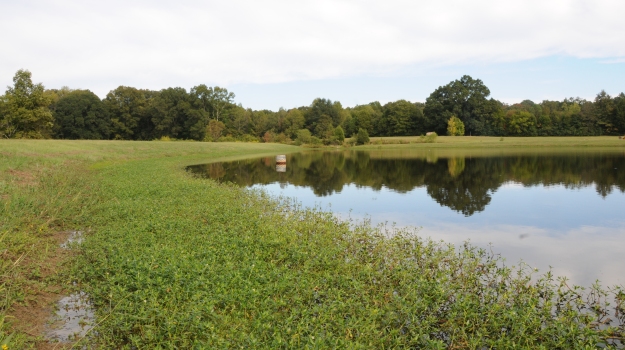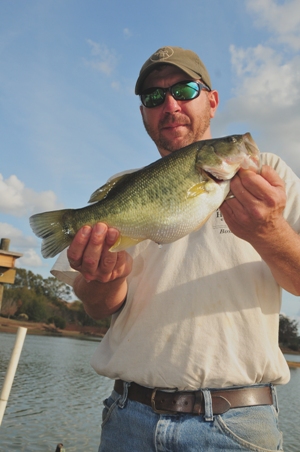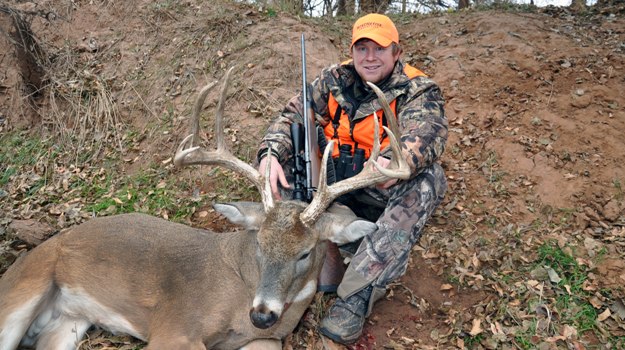Jason Patterson | ProStaff Regional Manager

Summertime can be one of the most frustrating times of the year for a bass angler because of the miserable summer heat. A lot of bass fishermen choose to stay inside this time of year and stay cool, and I don’t blame them. Dripping in sweat is not my idea of a pleasant day afield. Being a tournament angler for many years has made me learn the ins and outs of summertime fishing, and I am going to share with you some tips and tactics to help stay on the fish when the heat is on!
Knowing how bass relate to the time of the year is the key to catching consistent numbers of fish. In the spring, fish are moving up in the shallows to spawn and will attack most any bait thrown their way. After the spawn, fish move out to their summertime haunts and locate on structure. This is the time when fishermen wonder why they are only catching smaller fish beating banks. The majority of the big fish live in deep water all year long, only coming up to the shallows to spawn and feed. Granted, you can catch fish in the shallows most of the time, but to catch that monster you have to move off the bank a little and slow down.
I have caught most of my big fish over the years from fishing off-shore structures, and all of the tournaments that I have ever placed in have been because of the fish I caught in deeper water. Deep water is a relative term and will differ in every body of water that you fish. A shallow impoundment may only have six feet of deep water, while larger lakes have water that may be twenty-five feet deep or more. A fisherman really just needs a change in depth.
After many years of losing in bass fishing competitions, I finally learned how to fish off-shore structures. The first step to fishing for the monsters is to buy a map of the lake. A good lake map has contour lines to help you get started in the right direction. Look for sudden changes in depth, which is depicted when the contour lines run close together on the map. If you fish big impoundments, start out in a creek and move out toward the main lake. Some lakes actually have channel markers that tell you when there is a change in depth nearby. Most main lake points have deep water and good catches.
 When I first started learning how to fish deep water, I started by hopping from point to point and then venturing out to the ledges and other off-shore hotspots. If you fish bodies of water that do not have maps, observe the lay of the land. The trick is to imagine the lake with no water in it. Steep hills, for example, will continue to drop at the water’s edge. Electronics will show you everything you need to know about the lake. I find most of my off-shore locations now with my graph, and the new graphs today offer GPS to help remember your spots.
When I first started learning how to fish deep water, I started by hopping from point to point and then venturing out to the ledges and other off-shore hotspots. If you fish bodies of water that do not have maps, observe the lay of the land. The trick is to imagine the lake with no water in it. Steep hills, for example, will continue to drop at the water’s edge. Electronics will show you everything you need to know about the lake. I find most of my off-shore locations now with my graph, and the new graphs today offer GPS to help remember your spots.
There are several baits that will bring those lurkers from the depths. Deep diving crank baits are a good choice. When you locate a point or offshore brush pile, pull off the location and cast beyond the structure. Bump your crank bait into the brush to catch a monster.
Big spinner baits weighing about an ounce are also a good choice when fish are active. Cast out and let the spinner bait sink to the bottom; then slowly reel back to the boat. Crank bait and spinner bait colors range from a shad color to chartreuse with blue back. You can’t go wrong with these basic color combinations.
If you can’t get any action on those two baits, then it is time to slow down with a plastic worm. I use at least a nine inch worm and will move to an eleven inch worm when the bite is on. Watermelon, red shad, and purple are good color choices with a half-ounce to one-ounce weight. The worm requires slow dragging to entice strikes from hefty largemouths.
Big lizards are the next option if the worm is not bringing you strikes. I use, at the smallest, nine-inch lizards this time of year. Finally, you can use the jig and pig combo, and you’ll need a large jig that can reach far depths. Using the stroking-the-jig technique is the best way to catch a large fish.
These baits are your weapon kit needed to conquer off-shore structures. I can attest that these are the most exciting ways to catch big bass.
Learning to fish a new technique is always a little intimidating at first. I have caught the majority of my fish over six pounds in water deeper than eight feet. Most of the bass by the off-shore structures will run close to the same size, which means you could easily catch five-pounders on every cast. Shad is the number one food source when fishing deep water, and the bigger fish are usually always nearby.
Fishing off shore structure is the best advice right now in the bass fishing world because some of the bass in reservoirs and impoundments have never even seen a lure. Summertime is the best time of year to catch largemouth bass, but it takes some work to find and learn the secrets of the deep. With a good map and your trusty electronics, you too can expand your bass fishing knowledge. Go after them and enjoy what the Creator has given you!
Let us know what you do during the Summer Slump by sharing on our Facebook page and on Twitter and Instagram by mentioning @mossyoak with the hashtag #summerslump.




























